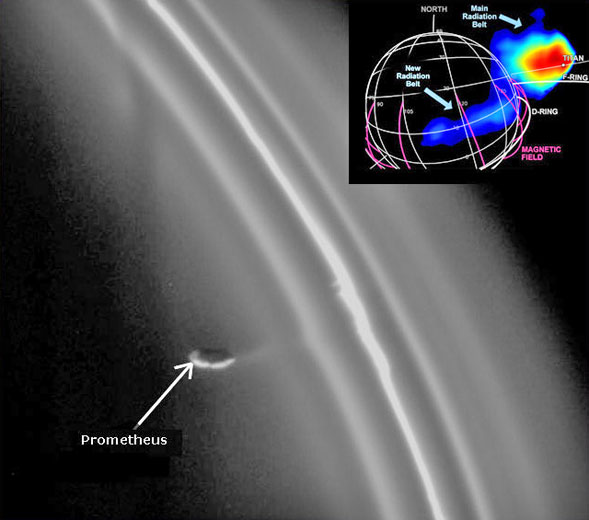|


from
Thuntherbolts Website
Dec 09, 2004

Credit:
NASA/JPL/Space Science Institute
In Greek legend,
Prometheus steals fire from the gods to give to man.
Unfortunately the story is misunderstood because the "fire of the
gods" was electrical. The similarity of an
electric discharge to fire lies in the fact that both are a
plasma. However, an electrical discharge in a plasma
may be invisible, unlike most flames. There is a plasma
discharge mode known as a "dark discharge". It may be
felt as a wind, or movement of particles in the direction of
the electric field. It will be familiar as the breeze from an air
ionizer.
Pictured above is Saturnís little moon
Prometheus, nestled inside the gas giantís F ring.
The report accompanying the image says,
"In an image taken
on Oct. 29, Prometheus is seen stealing particles
from the F ring while connected to the ringlets by
a faint streak of material.
" ... Scientists are
not sure exactly how Prometheus is interacting
with the F ring here, but they have speculated
that the moon might be gravitationally pulling material away
from the ring. Scientists speculate that the ring particles may
end up in a slightly different orbit from the one they were in
prior to getting a íkickí from the moon. These kicks occur at
specific locations in the rings and can actually cause large
waves or knots to form. In the still image, gaps in the diffuse
inner strands are seen. All these features appear to be due to
the influence of Prometheus in ways that are not
fully understood."
It is unlikely that the
influence of tiny, potato-shaped Prometheus on
Saturnís F ring can be understood in purely
gravitational terms. A giveaway to the electrical nature of the
interaction can be seen in the spiky projections, or "faint
streaks", projecting from the F ring toward
Prometheus. Faint streaks like that are seen in comet tails,
which are also an electrical discharge phenomenon.
But is Prometheus stealing material from the rings or
is it losing material to the rings in a comet-like electrical
discharge? Is Prometheus undergoing electric discharge
machining (EDM) and providing fine dusty material for
the F Ring? The same process could account for the odd
discovery that Saturnís A and B
rings are clean water ice while the Cassini division
between them is very dirty. There was probably a small moon orbiting
there which has recently been machined to dust.
If this model is correct we should expect to see a freshly
cratered surface on Prometheus, rather like that of
Comet Wild 2, if the opportunity arises to see Prometheus
more closely.
|
